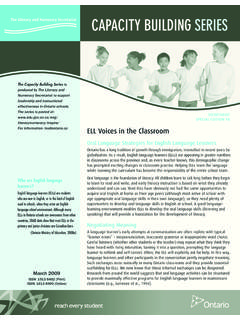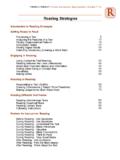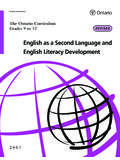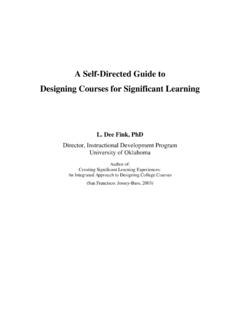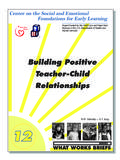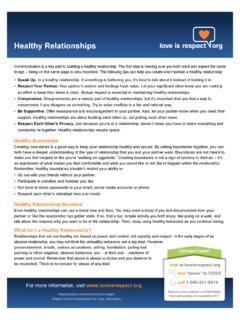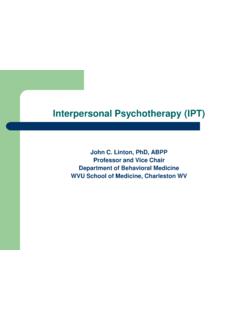Transcription of The Power of Positive Adult-Child Relationships ...
1 The Power of Positive Adult child Relationships : Connection Is the KeyWritten by Dr. Jean Clinton McMaster UniversityConnection Is the KeyAs you begin this article, think about what it means to make a connection to another, and think about the strong connections you have with the children in your care. In our hearts and minds we are likely to feel connected to those we spend our days with, but routinely, we may find ourselves spending more time on Correcting and Directing, leaving little time for Connecting. On a daily basis, what is your C:D:C Ratio? The Connection to LearningHow do children learn? For many years, the focus in research has been on how children learn to think and how they develop language and communication skills. Much less research has investigated how children learn to feel and express emotions, and how they develop the ability to become the boss of those feelings.
2 This ability to manage emotions is part of self-regulation (see Dr. Shanker s research brief on self-regulation). It is strange to consider now, but for a long time emotional development was considered unimportant, secondary to higher order functions such as reason (Damasio, 1994). We know now that all areas are interconnected and developing together emotions, language, thinking rendering it ineffective to focus on one area without the others. Children learn best in an environment that acknowledges this interconnectivity and thus focuses on both emotional and cognitive development. There is now an explosion of knowledge that tells us that healthy development cannot happen without good Relationships between children and the important people in their lives, both within BLEED2 The Power of Positive Adult-Child Relationships : Connection is the keythe family and outside of it.
3 As Dr. Jack Shonkoff states, young children experience their world as an environment of Relationships , and these Relationships affect virtually every aspect of their development (National Scientific Council on the Developing child , 2004). Relationships are the active ingredient in healthy development, especially brain and Emotional Learning (SEL) is a term used to describe the process through which children (and adults ) develop skills to support their success in learning, forming good Relationships , solving problems, and adapting to new situations - skills such as self-awareness, self-control, the ability to work cooperatively with others and to be caring and empathetic (Goleman, 2006). Social and Emotional Learning How do children learn about the world? Babies are born learning. When they interact with others, babies are like little scientists, observing faces and gestures and noticing everything around them.
4 Dr. Andy Meltzoff has shown that babies as young as one month begin to imitate faces (Meltzoff, 1977). By one year of age they turn to see mom s reaction when they are shown something new If there s a smile, they ll crawl forward to investigate; if there s horror, they ll stop dead in their tracks (Gopnik, A., Meltzoff, A. N. & Kuhl, P., 2008, p. 33). They learn to soothe themselves by being soothed. It s a two way street of serve and return (National Scientific Council on the Developing child , 2004). We are wired to connect to others. Infant, Toddler and Preschooler s WorldThis holds true for other age groups as well. The world of infants, toddlers and preschoolers is one of extraordinary brain activity and learning. We all learn by observing others and we seek connection and relationship . Our brain is a social organ wired to reach out and help others.
5 Why is that so likely for survival. Our babies and young children need far more protection than other mammals. A couple of very interesting experiments illustrate that we start to show empathy and a desire to help very early in life. Dr. Karen Wynn s research at Yale is fascinating. She has 6-month-old babies watch animated circles and squares or puppets act out a mini drama. Some help a little character up a hill, some push him down. When given the choice to play with either puppet, most babies prefer the helper (Bloom, 2010). In another experiment, an adult tries to put books in a cupboard but instead of opening it he just keeps banging against it. The 18-month-old children in the study spontaneously come and open the cupboard for him. He never looked at them for help, they just knew. How? From all of the observing and relationship cues they had been receiving and responding to all their lives (Warneken & Tomasello, 2009).
6 3 Dr. Jean Clinton Implications for Caregivers and Early Childhood EducatorsWhat implications are there for caring for young children? A lot depends on what our mindset is and how we view our role. What do we understand our job to be? What we think, affects how we feel, affects how we act. For example, if we think that our job is to teach children all we can, so that they learn their numbers and letters and how to behave, then we may feel that kids need to do lots of things to learn and keep busy. We may act by setting up a program that mainly consists of adults directing the children through activities. This is concerning for several reasons. An adult-led emphasis on literacy and numeracy means other things need to be left out and what too often gets left out are the opportunities for learning through play. As the Council of Ministers of Education, Canada (CMEC) so clearly states: Experts recognize that play and academic work are not distinct categories for young children: creating, doing, and learning are inextricably linked.
7 When children are engaged in purposeful play, they are discovering, creating, improvising, and expanding their learning. Viewing children as active participants in their own development and learning allows educators to move beyond preconceived expectations about what children should be learning, and focus on what they are learning (CMEC, 2012). In reflecting on this, some very well-meaning early learning centres noted they had been putting children through many transitions in the day, in one example, as many as 19. The challenge is, how can you build Relationships with children if you are always interrupting their work, directing them to the new activity or routine, and correcting them if they don t follow your expectations for following the schedule? In contrast, among a growing number of early learning and child care programs, fostering Relationships with the children is a top priority.
8 They feel that children learn best in an environment that focuses on Relationships , and that if kids are strongly connected to their teachers they will learn more and have less challenging behaviours. They think through the lens of how will this affect our Relationships with the children . They look at how many transitions children go through and work to reduce transitions, and allow lengthy blocks of time where they can be connecting with the children through individualized care and play (Ministry of Education, 2007). For babies and children, care and teaching are inseparable. By thinking differently about learning, that is, not as skills and information taught through direction, but rather as a life-long process ignited by connection, we can feel confident that learning is underway as we interact in a warm and responsive manner.
9 With more connection, there is less need for correction and directing. When we truly follow what children are engaged in, we have to connect more with the child and things go more easily for all. 4 The Power of Positive Adult-Child Relationships : Connection is the keySimple Ways to Build Connections Things we can do are simple, but we need to make them more intentional. Here are some examples of ways to build connections modified from the Center on the Social and Emotional Foundations for Early Learning (Ostrosky, M. M. & Jung, E. Y., 2010): Be at the child s level for face-to-face interactions Use a pleasant, calm voice and simple language while making eye contact Provide warm, responsive physical contact Follow the child s lead and interest during play Help children understand your expectations by providing simple but clear explanations (not by directing)
10 Take the time to engage children in the process of resolving problems and conflicts, rather than reiterating classroom rules When children s behavior is challenging and disruptive, think about where and how they might have more success and redirect them there Foster thoughtfulness and caring by listening to children and by encouraging them to listen to others and share ideas Be genuine in acknowledging children for their accomplishments and effort by clearly saying what it is they have done well Beyond these specific strategies, adults can speed up the process of relationship -building by: Carefully analyzing each compliance task ( , time to go to paints ) and shifting that compliance task to a choice for children ( , Do you want to paint or do puzzles? ); and Carefully considering if some forms of challenging behavior can be ignored ( , loud voice) this is not ignoring behavior designed to elicit attention but ignoring in the sense of making wise and limited choices about when to pick battles over there is more connection, there is less need for correction and you can probably see by now, this shift in mindset naturally makes the C:D:C ratio better.





